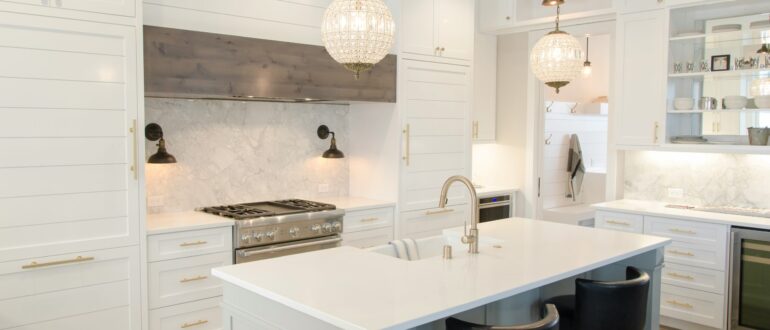Understanding the Unique Climate of Dubai
Dubai’s climate is characterized by extreme heat, high humidity during summer months, and frequent dust storms, all of which significantly impact the choice of materials for kitchen renovations. With temperatures often soaring above 40 degrees Celsius, it is essential to select materials that can withstand such intense heat without warping, fading, or deteriorating. For instance, materials such as ceramic tiles or modern laminate surfaces are ideal due to their ability to resist thermal expansion and contraction, ensuring long-lasting performance even in high temperatures.
Another critical factor is the humidity levels, which can reach high percentages during certain periods. This moisture can lead to mold and mildew growth, making it vital to choose materials that are moisture-resistant. Stainless steel, for example, is an excellent option for kitchen appliances and fixtures as it does not absorb moisture, while quartz countertops are another suitable choice due to their non-porous nature, limiting the risk of water damage. Additionally, ensuring that cabinetry is made from high-quality materials, such as marine-grade plywood, can enhance durability against humid conditions.
Dust is another ecological factor that often goes overlooked in kitchen renovation projects. Frequent sandstorms can result in fine particles accumulating in the kitchen, potentially damaging surfaces and appliances over time. Hence, opting for finishes that are easy to clean and maintain, like semi-gloss or high-gloss paints and wipeable surfaces, can significantly prolong the life of your kitchen renovation. Furthermore, employing good ventilation systems will help minimize dust accumulation and maintain air quality.
By understanding these unique climate factors in Dubai, homeowners can make informed decisions when selecting materials for their kitchen renovations, thus ensuring the longevity and durability of their investment.
Popular Materials for Kitchen Cabinets and Countertops
When planning a kitchen renovation in Dubai, selecting the right materials for cabinets and countertops is crucial, as the local climate can significantly impact their durability and maintenance. Several materials are popular among homeowners, each with its unique attributes and appeal.
Plywood, a versatile and cost-effective option, is favored for cabinetry due to its strength and resistance to warping. It consists of multiple layers of wood veneer glued together, providing a stable structure that is well-suited for the humid conditions often experienced in Dubai. While plywood is relatively affordable, its natural appearance can vary, and it may require protective coatings to enhance longevity.
Medium-density fiberboard (MDF) is another widely used material in kitchen cabinets. This engineered wood product is smooth and can be easily painted or veneered, making it an excellent choice for achieving a modern aesthetic. However, MDF can absorb moisture, so it is advisable to ensure proper sealing to prevent damage, especially in the event of high humidity.
Solid wood, known for its timeless beauty and durability, can add an element of elegance and warmth to any kitchen. However, it tends to be pricier and requires regular maintenance to preserve its finish and prevent warping caused by temperature fluctuations. In a hot climate such as Dubai, it is essential to choose hardwood varieties that can withstand these changes.
Regarding countertops, granite and quartz remain top choices among homeowners. Granite, a natural stone, offers exceptional durability and heat resistance; its unique patterns provide a luxurious look. However, it requires regular sealing to avoid stains. Quartz, on the other hand, is engineered and non-porous, making it resistant to bacteria and easier to maintain. It combines durability with a wide variety of colors and patterns, aligning well with contemporary kitchen design trends.
Ultimately, the selected materials for kitchen cabinets and countertops should reflect personal style, functionality, and maintenance preferences. Dubai’s dynamic environment emphasizes the importance of choosing materials that not only enhance the kitchen’s aesthetic appeal but also endure the region’s climatic challenges.
Flooring and Backsplash Options to Consider
When undertaking kitchen renovations in Dubai, the choice of flooring and backsplash materials is of paramount importance, as these elements significantly influence the aesthetics and practicality of the space. The climate in Dubai requires materials that are not only visually appealing but also durable and resistant to stains and scratches, ensuring longevity in high-traffic areas.
For flooring, ceramic tiles emerge as a popular choice, offering a variety of designs, sizes, and colors that can easily match any kitchen theme. Their resilience against stains and moisture makes them ideal for the humid conditions often experienced in Dubai. Another suitable option is vinyl flooring. Unlike traditional materials, modern vinyl is designed to withstand significant wear and tear while providing a softer underfoot. It is also available in designs that mimic natural stone or wood, allowing for versatile styling.
If natural aesthetics are preferred, natural stone such as granite or marble is an excellent selection. These materials bring elegance and sophistication to the kitchen; however, they do require regular sealing to prevent stains. Additionally, the pattern and color variations in natural stone offer a unique flair, making each installation distinct.
In terms of backsplash options, ceramic tiles again prove to be a solid choice due to their ease of cleaning and expansive design possibilities. Glass backsplashes have gained popularity for their reflective qualities, which can enhance light within the kitchen, creating a more open environment. Furthermore, laminate backsplashes provide an economical alternative while still offering a wide array of stylistic options.
When selecting colors and patterns for both flooring and backsplashes, it is important to consider the overall design of the kitchen. Opting for complementary hues can create a cohesive look, while contrasting patterns can add visual interest and depth. Ultimately, the right combination can enhance the kitchen’s ambiance, making it a functional yet stylish part of the home.




Comments 0